 Dive watches are unique for their tremendous water resistance and durability.
Dive watches are unique for their tremendous water resistance and durability.
Although commonplace now, when they were first introduced, with the bezel encircling the face they were also considered quite unique in appearance, and many of today’s moderns sports watches are indebted to them for their design and styling.
Basic description
Dive watches are made for underwater Divers, usually scuba Divers (sometimes saturation Dives).
These days they typically have a water resistance of 200-300 meters, a unidirectional bezel (except those with electronic displays) for measuring elapsed time, and a case made from material resistant to the corrosive nature of seawater, such as Titanium, Stainless Steel, Ceramic etc
A genuine Dive watch will need to conform to the ISO 6425 standard.
A watch that conforms to this will be clearly marked “Dive”.
ISO 6425 Standard Requirements
- Be water resistant to a minimum of 100m
- Have a unidirectional Bezel with 5 minute markings
- Be readable in total darkness at 25cm
- Show that its running -usually through an illuminous secondhand.
- Be Shock, Magnet and chemical resistant.
- Have a strap capable of withstanding 200N of force.
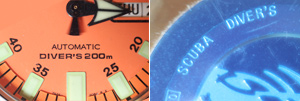
“Dive” markings on a Seiko “Orange Monster” SKX781
Development
The First Dive watch, the Omega Marine used a case within a case to achieve water resistance.
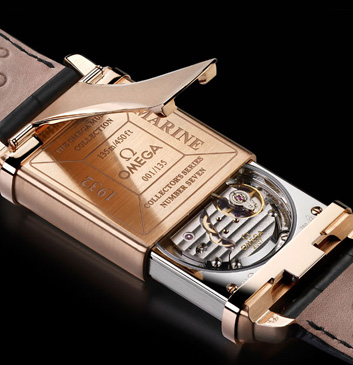
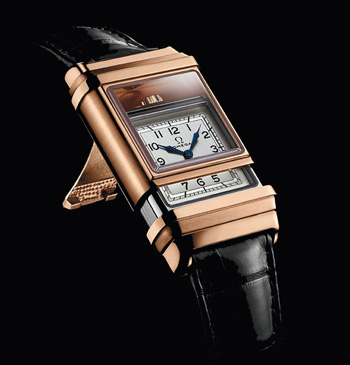
Watches were developed for the purpose of diving due to requirements from the military and then later due to commercial dive work that started to appear in the 1960’s .
As a result professional Dive organisations appeared with needs for “tool” watches to help conduct dives safely at great depth.
- 1927 Rolex is credited with creating the first waterproof* watch.
- 1932 Omega introduced the “Marine” considered to be the first dive watch.
- 1930’s Panerai produced a number of Dive watches for the Italian Navy water resistant to 650 feet.
- 1953 Blancpain produced the “Fifty Fathoms” as worn by Jacques Cousteau in the film “Le monde du silence”.
- 1954 Rolex introduced the “Submariner” -the watch of choice for James Bond in the first ten films.
- 1957 Omega Seamaster introduced.
- 1967 Rolex Sea-Dweller introduced, first “ultra water resistant” watch for diving, capable of depth to 610m.
- 1970 Omega Seamaster Professional introduced, capable of depth to 600m.
*The term Waterproof is no longer used. The International Organisation for Standardisation prohibited the term being used by watch manufacturers.
How Deep?
Related page: Ultra Deep Dive watches
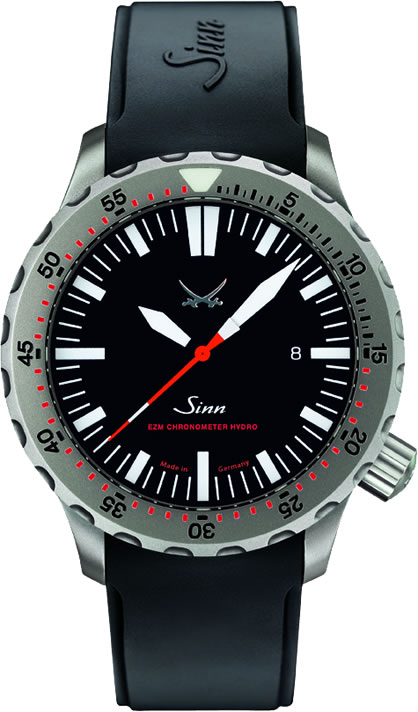
Sinn UX certified to 12,000 Meters
These days water resistance has become an expected feature in many types of watches and arguably over emphasised in importance.
A watch that is certified for a Dive to great depths is an indicator that the watch is extremely strong and durable, however it could be argued that some of these watches are over-engineered for marketing purposes.
Beginning in the 1970’s watches started appearing that were certified to depths even beyond 1000m, however to descend to anywhere near such depths is humanly impractical.
Some have even been manufactured using cases that are filled with Silicon oil due to their compression resistance, for example the Sinn UX above, is certified for a depth of 12,000 meters (however, the quartz movement can only withstand 5,000 meters)
Keeping the water out
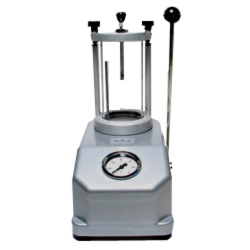
A Bergeon Watch Water Resistance Tester.
In order to make a watch water resistant gaskets are combined with sealant to make a watertight seal.
The case then has to be tested in order to be certified as water resistant.
Watches are tested to theoretical depths. For example a watch rated to 50 meters would be rated as such if it was stationary in 50 meters of water for a certain amount of time.
For this test the watch is placed into a depressurizing chamber. The movement of the case and crystal is monitored by a sensor, no water is used in this test.
For deeper tests a different method is used. The watch is immersed in water inside a small chamber. Pressure is then applied, usually for just a couple of minutes to determine whether the watch can withstand the right amount of pressure. No movement is used during these tests so it is factored in afterwards to determine the overall water resistance.
Meters, Bar, ATM.
Various measurements are in use for rating Diver watches water resistance, bar is equivalent to ten times one meter so 10 Bar is equal to 100m, ATM is also used and this is roughly equivalent to bar.
The basic rule is 1ATM= 1BAR= 10m= 33.3ft
Bezel

An instantly recogniseable feature of Dive watches are their (Uni-directional) Bezel encircling the watchface, this has become historically synonymous with this type of watch.
Most dive watches have a bezel excepting those that use electronic displays.
A lot of people, including some owners of Dive watches don’t fully understand the purpose and function of the bezel.
Its purpose is a safety feature used to measure the time of a dive and consequently the amount of oxygen used. To use it, you align the bezels pointer to the minute hand, you can then judge how much time has elapsed.
Features a bezel should ideally have :
- Easy to read minute markings as well as number markers at ten minute increments.
- A distinct zero marker indicating the zero starting point.
- Be tight fitting so that it doesn’t move too easily, to prevent accidental movement.
- A ratchet mechanism for precise measurement (typically 120 clicks)
- A Notched outer edging making it easy to grip when wet or wearing gloves.
- Turn counter clockwise only (uni-directional), an important safety feature so that if knocked accidentally it will only show a longer time, causing the diver to ascend earlier rather than later.
Other considerations: if the bezel is higher than the watches glass it helps prevent scratching.
If the bezel has a smaller diameter than the case it helps prevent accidental movement of the bezel.
Watch strap
The choices you have for a strap are typically Rubber, Stainless Steel or Titanium.
Rubber: If its genuine – best to check- rubber is strong, comfortable and flexible. It will last for quite some time but will eventually deteriorate, become brittle and susceptible to tearing. Read about maintenance and how to extend the life of the rubber band below.
Stainless Steel: Is fine for Dive watches the only thing to watch out for is checking that its genuine Stainless Steel since other metal straps will rust or corrode.
Titanium: The best choice, if you can afford it. Stronger by one third than Stainless Steel and significantly lighter too, making it feel more comfortable as well. More durable and more corrosion resistant than Stainless Steel its also hypoallergenic, which may be another consideration.
Further consideration:wetsuit clasp
This is a special clasp that makes the strap extendable so its easy to adjust and wear over a wetsuit.
Cost, quality considerations.
If you’re serious about using your dive watch for the purpose it was intended then it is best to spend your money on the genuine article.
Why? Because having your Dive watch fail on you when you’re at a great depth can cause serious injury or even death.
You need to rely on your watch to tell you accurately the length of your dive, if it fails then you wont know how long you’ve stayed down so you may run out of oxygen.
Further, you could stay down too long and suffer a decompression illness (DCI) also known as the “bends.”
Also by knowing how long you’ve stayed down you can avoid staying down too long and having to go through “decompression”.
So if your Dive watch fails, you wont know if you’ve gone beyond the no-decompression limit, and if you have, you also wont know how long to decompress for, or be able to time it.
A decompression illness is caused by nitrogen bubbles developing in or around the body’s joints.
This causes the body to react, and numbness, paralysis or cerebral damage may occur as a result.
So its not worth taking the risk of relying on cheap or inferior quality Dive watches.
Maintenance
Water resistance
Its important to consider that water resistance isnt a permanent condition. When a dive watch is new it will meet the ratings indicated by the manufacturer. However the gaskets sealing the watch will over time become dry and brittle and as a result the watches water resistance will decrease.
Furthermore, exposure to chlorinated pools, salt water or soaps from showering will increase the speed at which the gaskets become dry and brittle.
Therefore in order to maintain water resistance its recommended that the gaskets are changed every 18 months or even less if the watch is exposed to chlorinated pools on a daily basis. Its always best to consult the watchmaker fof clear guidlines.
Watch Bands
Metal
After a period of time dirt, perspiration and other materials may accumulate in the links and joints of the watch band, this can cause the finish to dull and may even cause damage. The best way to clean a metal band is to use a soft brush and warm soapy water, thoroughly rinsing it with clean water afterwards.
Never use alcohol based cleaners such as benzine as this could damage the finish and also may cause skin irritation.
Rubber
You can extend the life of a rubber strap by periodically cleaning it with mild detergent and a soft brush. After being exposed to salt water rinse it with clear water. You can also use a rubber protectant to keep it pliable, the more pliable and dry it is kept the longer it will last.

[…] term “diver’s watch” is strictly governed by the corresponding ISO standards. The Admiral’s Cup Seafender 48 Deep Dive meets all these essential criteria: its imposing case […]
[…] the first few google hits: https://en.wikipedia.org/wiki/Water_Resistant_mark http://uniquewatchguide.com/dive-watches.html http://articledunia.com/what-is-a-divers-watch/ back to the top of […]